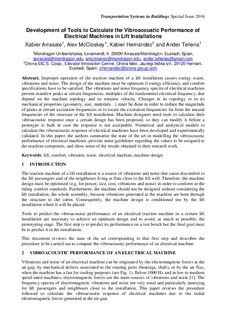| dc.rights.license | Attribution 4.0 International | * |
| dc.contributor.author | Arrasate, Xabier | |
| dc.contributor.author | McCloskey, Alex | |
| dc.contributor.author | Telleria San Torcuato, Ander | |
| dc.contributor.other | Hernández, Xabier | |
| dc.date.accessioned | 2018-10-25T12:34:43Z | |
| dc.date.available | 2018-10-25T12:34:43Z | |
| dc.date.issued | 2017 | |
| dc.identifier.issn | 2631-8156 | eu_ES |
| dc.identifier.other | https://katalogoa.mondragon.edu/janium-bin/janium_login_opac.pl?find&ficha_no=125899 | eu_ES |
| dc.identifier.uri | https://hdl.handle.net/20.500.11984/1108 | |
| dc.description.abstract | Improper operation of the traction machine of a lift installation causes energy waste, vibrations and noise. The design of the machine must be optimum if energy efficiency and comfort specifications have to be satisfied. The vibrations and noise frequency spectra of electrical machines present manifest peaks at certain frequencies, multiples of the fundamental electrical frequency, that depend on the machine topology and its rotation velocity. Changes in its topology or in its mechanical properties (geometry, size, materials…) must be done in order to reduce the magnitude of peaks at certain excitation frequencies or to locate the excitation frequencies far from the natural frequencies of the structure or the lift installation. Machine designers need tools to calculate their vibroacoustic response once a certain design has been proposed, so they can modify it before a prototype is built in case the response is not acceptable. Numerical and analytical models to calculate the vibroacoustic response of electrical machines have been developed and experimentally validated. In this paper, the authors summarise the state of the art in modelling the vibroacoustic performance of electrical machines, provide some guidelines regarding the values to be assigned to the machine componets, and show some of the results obtained in their research work. | eu_ES |
| dc.description.sponsorship | Orona EIC | eu_ES |
| dc.language.iso | eng | eu_ES |
| dc.publisher | University of Northampton | en |
| dc.rights.uri | http://creativecommons.org/licenses/by/4.0/ | * |
| dc.subject | lift | eu_ES |
| dc.subject | comfort | eu_ES |
| dc.subject | vibration | eu_ES |
| dc.subject | noise | eu_ES |
| dc.subject | electrical machine | eu_ES |
| dc.subject | machine design | eu_ES |
| dc.title | Development of Tools to Calculate the Vibroacoustic Performance of Electrical Machines in Lift Installations | eu_ES |
| dcterms.accessRights | http://purl.org/coar/access_right/c_abf2 | eu_ES |
| dcterms.source | Transportation Systems in Buildings. Special Issue | eu_ES |
| local.contributor.group | Acústica y vibraciones | eu_ES |
| local.description.peerreviewed | true | eu_ES |
| local.identifier.doi | https://doi.org/10.14234/tsib.v1i1.122 | |
| local.relation.projectID | PROYECTO PROVA PROVA | eu_ES |
| local.source.details | Vol. 1. Nº 1, 2017 | eu_ES |
| oaire.format.mimetype | application/pdf | |
| oaire.file | $DSPACE\assetstore | |
| oaire.resourceType | http://purl.org/coar/resource_type/c_6501 | eu_ES |
| oaire.version | http://purl.org/coar/version/c_970fb48d4fbd8a85 | eu_ES |








